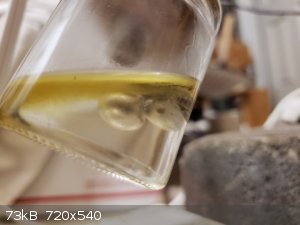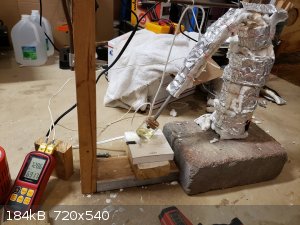Darien
Harmless

Posts: 25
Registered: 19-1-2017
Member Is Offline
Mood: No Mood
|
|
Any uses for lithium metal
I know about the Birch reduction and the distillation of cesium and rubidium. Are there any other cool uses for lithium metal for home chemistry?
|
|
|
WGTR
National Hazard
   
Posts: 971
Registered: 29-9-2013
Location: Online
Member Is Offline
Mood: Outline
|
|
Lithium easily reacts with nitrogen to form lithium nitride. Reacting this product with water forms ammonia. The ammonia can then be oxidized
catalytically to nitric oxide and then nitric acid.
I'm not saying this pathway is economically practical, but I think it's interesting and kind of cool.
|
|
|
Bedlasky
International Hazard
    
Posts: 1219
Registered: 15-4-2019
Location: Period 5, group 6
Member Is Offline
Mood: Volatile
|
|
Lithium carbide from acetylene and lithium in liquid ammonia.
You can also try to make solution of lithium electride in certain amines:
https://woelen.homescience.net/science/chem/exps/electride/
|
|
|
zed
International Hazard
    
Posts: 2277
Registered: 6-9-2008
Location: Great State of Jefferson, City of Portland
Member Is Offline
Mood: Semi-repentant Sith Lord
|
|
Yah! You can use your Lithium Deutride and Tritride, in your thermonuclear fusion devices.
You can ingest your Lithium as Carbonate, and thereby stabilize your Manic Depression, but your friends might think you less fun, and you will surely
be less likely to entertain yourself by detonating those aforementioned Thermonuclear fusion devices.
|
|
|
karlos³
International Hazard
    
Posts: 1520
Registered: 10-1-2011
Location: yes!
Member Is Offline
Mood: oxazolidinic 8)
|
|
Lithium acetylide can be made, ideally without high pressure and such, when prepared as the ethylenediamine complex.
And other lithiumorganic stuff, phenyllithium is not so bad too for example.
|
|
|
clearly_not_atara
International Hazard
    
Posts: 2691
Registered: 3-11-2013
Member Is Offline
Mood: Big
|
|
Lithium can form radical anions with some polyaromatic compounds, such as naphthalene, biphenyl, etc. These can have interesting colors and are useful
in the preparation of finely divided metals (Rieke metal), such as manganese or zinc, from nonaqueous solutions of their halides.
[img]https://en.wikipedia.org/wiki/Sodium_naphthalene#/media/File:Lithium_Naphthalenide.jpg[/img]
[Edited on 04-20-1969 by clearly_not_atara]
|
|
|
metalresearcher
National Hazard
   
Posts: 731
Registered: 7-9-2010
Member Is Offline
Mood: Reactive
|
|
You can make potassium metal by heating KCl and Li metal in a stainless steel retort heated to 800 C.
I have done that successfully using a copper tube attached to the retort which ends in the condensor under mineral oil. It just distills off as K
metal boils at 768 C so the equilibrium of
Li + KCl <=> K + LiCl
(liquids) (vapor + liquid)
shifts to the right.
The same applies to Na but requires a slightly higher temperature (900 C) as the b.p. of Na is 883 C.
|
|
|
Triflic Acid
Hazard to Others
  
Posts: 486
Registered: 27-9-2020
Member Is Offline
Mood: Slowly Oxidizing into Oblivion
|
|
Take a large chunk, and cast it down into the shape of L and i. Then encase your new element sample in resin for display on the shelf.
There wasn't a fire, we just had an uncontrolled rapid oxidation event at the power plant.
|
|
|
Schleimsäure
Hazard to Others
  
Posts: 156
Registered: 31-8-2014
Location: good ole Germany
Member Is Offline
Mood: Probably
|
|
With 1-Chlorobutane it will form the very versatile n-Butyllithium.
|
|
|
Darien
Harmless

Posts: 25
Registered: 19-1-2017
Member Is Offline
Mood: No Mood
|
|
The polyaromatic anions and the making of potassium metal sound like tempting projects. If I had chlorobutane that would also be an interesting
project.
|
|
|
Keras
National Hazard
   
Posts: 766
Registered: 20-8-2018
Location: (48, 2)
Member Is Online
|
|
Quote: Originally posted by Darien  | | The polyaromatic anions and the making of potassium metal sound like tempting projects. If I had chlorobutane that would also be an interesting
project. |
You can use 1-bromobutane instead. It is really easy to prepare, once you have HBr, which is another interesting preparation on its own (from, say,
sulphuric acid and NaBr — or I was told that phosphoric acid could work, too).
|
|
|
MidLifeChemist
Hazard to Others
  
Posts: 192
Registered: 4-7-2019
Location: West Coast USA
Member Is Offline
Mood: precipitatory
|
|
If you heat lithium in a propane furnace at high temperatures for several minutes at 500C, let it cool, and then place it in water, it will react
vigorously, giving off not only hydrogen, but some of the foulest smallest gas you have ever experienced. It's something everyone should see at least
once!
|
|
|
Triflic Acid
Hazard to Others
  
Posts: 486
Registered: 27-9-2020
Member Is Offline
Mood: Slowly Oxidizing into Oblivion
|
|
What happens that gives it a smell?
There wasn't a fire, we just had an uncontrolled rapid oxidation event at the power plant.
|
|
|
MrHomeScientist
International Hazard
    
Posts: 1806
Registered: 24-10-2010
Location: Flerovium
Member Is Offline
Mood: No Mood
|
|
Quote: Originally posted by Triflic Acid  | | Take a large chunk, and cast it down into the shape of L and i. Then encase your new element sample in resin for display on the shelf.
|
Molten lithium is incredibly reactive. I wouldn't recommend melting it without extensive research on what can handle it. Plus you'd have to do the
whole operation in an inert atmosphere.
|
|
|
Metallophile
Hazard to Self
 
Posts: 82
Registered: 23-3-2018
Member Is Offline
Mood: No Mood
|
|
Quote: Originally posted by metalresearcher  | You can make potassium metal by heating KCl and Li metal in a stainless steel retort heated to 800 C.
I have done that successfully using a copper tube attached to the retort which ends in the condensor under mineral oil. It just distills off as K
metal boils at 768 C so the equilibrium of
Li + KCl <=> K + LiCl
(liquids) (vapor + liquid)
shifts to the right.
|
I've seen this also works for Cs, on a video by Cody'sLab. I have a small jar of cesium hydroxide, and would like to try this. Would the reaction work
with CsOH? Or should I turn it into chloride first? It melts much lower, but I guess I'd still need the higher temp to vaporize the Cs.
|
|
|
Triflic Acid
Hazard to Others
  
Posts: 486
Registered: 27-9-2020
Member Is Offline
Mood: Slowly Oxidizing into Oblivion
|
|
Use the chloride. The hydroxide must have some water, plus it might decompose to form water 2CsOH --> Cs2O + H2O. That will destroy your cesium as
well as start a nasty fire. Use the scrupulously dried chloride.
There wasn't a fire, we just had an uncontrolled rapid oxidation event at the power plant.
|
|
|
Metallophile
Hazard to Self
 
Posts: 82
Registered: 23-3-2018
Member Is Offline
Mood: No Mood
|
|
I successfully made some potassium metal this weekend with this method! While I am happy that it worked, I am disappointed with the efficiency.
Starting with 7.78g of KCl and 1.22g of Li (a 68% excess), I produced 0.76g of K metal. I calculate that to be about 19% yield from KCl. Any ideas
what could make this so bad? I used carbon fiber fabric to seal the threads, and that seemed to work pretty well. When everything cooled off, I took
it apart and saw mostly white salt at the bottom of the retort. There was a little bit of black crud on the sides higher up, but it seemed far too
hard and crunchy to be Li or K. Any remaining metal would have floated on the salt, right? I used an excess of Li, so there should have been something
left in there. Where could it have gone?
 
|
|
|
Fantasma4500
International Hazard
    
Posts: 1677
Registered: 12-12-2012
Location: Dysrope (aka europe)
Member Is Offline
Mood: dangerously practical
|
|
dunk it in MeOH, and put a bit of that into a gas cannon and shoot at night for great entertainment
lithium methoxide, can probably be used for some reductions or methylations - dont hang me up on this.
i believe you can also make calcium metal with lithium
@Metallophile
your retort seems quite tall- why is it so? threads may eventually fail you, consider looking into constructing a flange connection device instead
|
|
|
Metallophile
Hazard to Self
 
Posts: 82
Registered: 23-3-2018
Member Is Offline
Mood: No Mood
|
|
Quote: Originally posted by Antiswat  |
@Metallophile
your retort seems quite tall- why is it so? threads may eventually fail you, consider looking into constructing a flange connection device instead
|
A lot of it is insulation. The pipe itself is 21mm ID x 150mm long. The neck tube is 7mm x 460mm, and some of the height is due to the 135 degree bend
I had to make, without kinking the tube. I am definitely up for design improvements though! I will say, the 316 stainless has held up very well, and
it also has a surprisingly low thermal conductivity.
An interesting thing I noticed when cleaning up after that first attempt, was a strong whiff of ammonia when rinsing the retort with water. I'm
guessing I made some Li3N? That wasn't really too surprising by itself. What I hadn't considered though, is that as the nitrogen reacts into a solid,
more fresh air will be drawn in, and all of the lithium metal could eventually be consumed this way! I bought some "Bloxygen" canned argon, and I'm
going to give it another try.
|
|
|